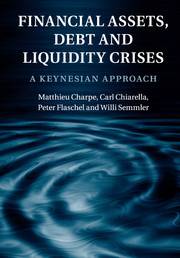Financial Assets, Debt and Liquidity Crises, A Keynesian Approach
Carl Chiarella, Peter Flaschel
Éditeur : CAMBRIDGE UNIVERSITY PRESS
ISBN papier: 9781107546660
Parution : 2015
Code produit : 1307974
Catégorisation :
Livres /
Gestion /
Économie /
Macroéconomie
Formats disponibles
| Format | Qté. disp. | Prix* | Commander |
|---|---|---|---|
| Livre papier | En rupture de stock** |
Prix membre : 58,80 $ Prix non-membre : 61,89 $ |
*Les prix sont en dollars canadien. Taxes et frais de livraison en sus.
**Ce produits est en rupture de stock mais sera expédié dès qu'ils sera disponible.
Description
The macroeconomic development of most major industrial economies is characterised by boom-bust cycles. Normally such boom-bust cycles are driven by specific sectors of the economy. In the financial meltdown of the years 2007–9 it was the credit sector and the real-estate sector that were the main driving forces. This book takes on the challenge of interpreting and modelling this meltdown. In doing so it revives the traditional Keynesian approach to the financial-real economy interaction and the business cycle, extending it in several important ways. In particular, it adopts the Keynesian view of a hierarchy of markets and introduces a detailed financial sector into the traditional Keynesian framework. The approach of the book goes beyond the currently dominant paradigm based on the representative agent, market clearing and rational economic agents. Instead it proposes an economy populated with heterogeneous, rationally bounded agents attempting to cope with disequilibria in various markets. • Provides an integrated view of the underlying mechanism of financial crises • Extends the Keynesian tradition to include a detailed financial sector • Integrates distributive cycle with the dynamics of effective demand and the dynamics of financial markets























